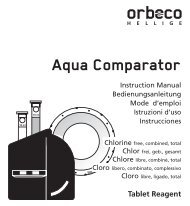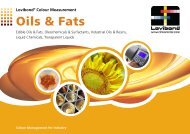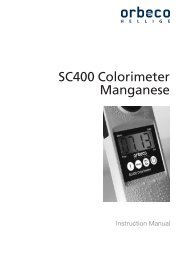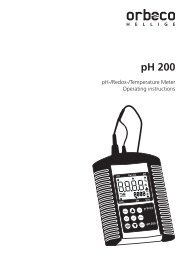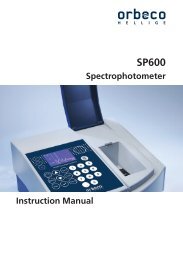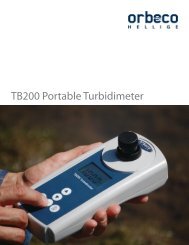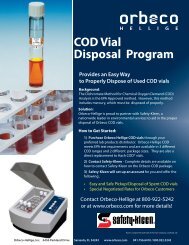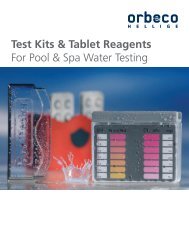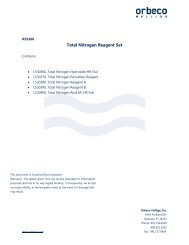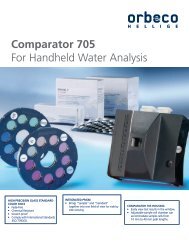SensoDirect pH 200 - Orbeco-Hellige
SensoDirect pH 200 - Orbeco-Hellige
SensoDirect pH 200 - Orbeco-Hellige
Create successful ePaper yourself
Turn your PDF publications into a flip-book with our unique Google optimized e-Paper software.
<strong>SensoDirect</strong> <strong>pH</strong> <strong>200</strong><br />
<strong>pH</strong>-/Redox-/Temperature Meter<br />
Operating instructions<br />
%<br />
°C<br />
°C<br />
MEAS<br />
HOLD °F
Table of Contents<br />
Page<br />
1. Scope of delivery ...............................................................4<br />
2. System description.............................................................4<br />
3. Connections.......................................................................5<br />
4. Display ..............................................................................7<br />
5. Keypad .............................................................................7<br />
6. Start up..............................................................................8<br />
7. Measurement.....................................................................9<br />
8. Configuration of the unit...................................................11<br />
8.1 Selection of measuring function [<strong>pH</strong>] – [mV] – [Rel mV].....11<br />
8.2 Calibration: selection of calibration...................................12<br />
8.3 Display of electrode status ..............................................12<br />
8.4 Selection of temperature unit °C /°F ................................14<br />
8.5 Power off: automatic unit switch-off.................................14<br />
9. Calibration of <strong>pH</strong> measurement........................................14<br />
9.1 Starting calibration: Press [CAL] key.................................16<br />
9.2 Selecting buffer solutions..................................................16<br />
9.3 Calibration point 1: ‘CAL. 1’.............................................17<br />
9.4 Calibration point 2: ‘CAL. 2’ ............................................18<br />
9.5 Calibration point 3: ‘CAL. 3’.............................................20<br />
10. Result memory.................................................................21<br />
10.1 Storing results..................................................................21<br />
10.2 Displaying stored results...................................................21<br />
10.3 Deleting stored results......................................................22<br />
11. Error messages and troubleshooting................................22<br />
12. Technical data..................................................................25<br />
13. Accessories......................................................................27<br />
14. Assembling Carrying strap................................................27<br />
3
1. Scope of delivery<br />
Standard:<br />
• <strong>Orbeco</strong>-<strong>Hellige</strong> <strong>SensoDirect</strong> <strong>pH</strong> <strong>200</strong><br />
• Batteries, 4*AA 1,5 V cells<br />
• Operating instructions<br />
• Carrying strap<br />
Set:<br />
• <strong>Orbeco</strong>-<strong>Hellige</strong> <strong>SensoDirect</strong> <strong>pH</strong> <strong>200</strong><br />
• Batteries, 4*AA 1,5 V cells<br />
• <strong>pH</strong>/Temperature sensor<br />
• Standard buffer solutions, each 90 ml <strong>pH</strong><br />
4.00/7.00/ 10.00<br />
• Carrying case<br />
• Operating instructions<br />
• Carrying strap<br />
2. System description<br />
The system is a sturdy, water-tight handheld meter<br />
designed for daily measurements in the area of field<br />
or laboratory analysis.<br />
It is used to measure redox voltage and temperature<br />
in the field of environmental analysis as well as for<br />
applications in the food and chemical industries.<br />
The system complies with the requirements in EN<br />
60529 relating to protection class IP67 and waterproof/dustproof<br />
properties.<br />
4
The permanent protective plating on the unit serves not<br />
just as impact protection but also as a storage compartment<br />
for the electrode and as an anti-slip device<br />
when the meter is used in an upright position.<br />
Microprocessor technology and 4 x AA 1,5 V batteries<br />
allow unit operation without battery change for 15,000<br />
hours or more.<br />
A „Low Bat” indicator in the display shows the user<br />
when it is time to change the batteries.<br />
The required temperature compensation for the system<br />
is performed automatically (ATC) following connection<br />
of a temperature sensor or via manual input via the<br />
touch-sensitive film keypad. The unit automatically<br />
identifies Pt1000 and NTC 30 kOhm sensors.<br />
The AUTO HOLD feature enables the user to identify<br />
stable results and call them up on the display.<br />
The MEAS function is the standard continuous measuring<br />
mode for <strong>pH</strong> levels or redox voltages.<br />
<strong>pH</strong> calibration of the system is via an integrated automatic<br />
buffer recognition feature.<br />
The temperature characteristics of the Tintometer<br />
standard buffer solutions and the reference buffer<br />
solutions specified in DIN 19266 are stored in the unit<br />
and are used for automatic calibration of the system<br />
when selected.<br />
It is additionally possible to enter some of the buffer<br />
data into the unit manually.<br />
Calibration is performed optionally at 3 points, 2 points<br />
or 1 point.<br />
A sensor evaluation is automatically shown in the<br />
display (or can be called up via the menu) after each<br />
calibration.<br />
An internal memory for 20 results is integrated in the<br />
5
MEAS<br />
1 2 3<br />
4 5 6<br />
7 8 9<br />
unit as standard. The memory stores location, result<br />
and temperature.<br />
The memory is called up via the display.<br />
mV mmHg Rel hPa mVmg/l %O2 <strong>pH</strong><br />
%<br />
°C<br />
°C<br />
HOLD °F<br />
ATC SAL OK CAL OK CAL hPa<br />
3. Connections<br />
Temperature sensor “T”, 4mm<br />
1-pin<br />
T<br />
REF<br />
Temperature sensor “REF”<br />
and separately routed<br />
reference electrode, if present,<br />
4mm 1-pin<br />
<strong>pH</strong> or redox electrode, HF<br />
socket in acc. with DIN 19262<br />
6
4. Display<br />
Main display:<br />
[mV]<br />
[Rel mV]<br />
[<strong>pH</strong>]<br />
Secondary display:<br />
Result or user prompt<br />
Redox voltage, absolute<br />
Redox voltage, relative to the<br />
hydrogen electrode (DIN 38404)<br />
<strong>pH</strong> level<br />
Result - temperature<br />
or user prompt<br />
mV<br />
Rel mV<br />
[%] Percent (sensor evaluation)<br />
ATC OK CAL<br />
[∆! ]<br />
Warning index - battery/ one-point calibration<br />
<strong>pH</strong><br />
%<br />
°C<br />
MEAS<br />
°C<br />
HOLD °F<br />
[°C,°F]<br />
[ATC]<br />
[OK]<br />
[CAL]<br />
[MEAS]<br />
[HOLD]<br />
Temperature unit<br />
Automatic temperature compensation<br />
Stable measuring signal<br />
Calibration mode<br />
Measuring mode - standard<br />
Measuring mode - AUTO-HOLD<br />
5. Keypad<br />
Meas<br />
Hold<br />
on/off<br />
[▲] [▼]<br />
Rcl<br />
Cal<br />
Store<br />
Menu<br />
Continuous measurement,<br />
(standard setting)<br />
Auto Hold: automatic retaining<br />
of stable result<br />
On/Off<br />
Leaf through menu or memory,<br />
manual temperature setting<br />
Display of stored results<br />
Calibration mode<br />
Storage of current<br />
result or acceptance of<br />
unit configuration<br />
Unit configuration<br />
Meas<br />
Cal<br />
Hold Rcl Store<br />
On<br />
Off<br />
Menu<br />
7
6. Start up<br />
The unit is supplied with integrated batteries as standard<br />
and is therefore ready for immediate use.<br />
You have to unscrew the unit to insert or change the<br />
batteries. When inserting the batteries, ensure correct<br />
polarity!<br />
Screw the unit back together carefully without exerting<br />
too much pressure on the gasket seal.<br />
Display<br />
Remove<br />
6 screws<br />
Don`t<br />
touch<br />
4 x AA 1,5 V<br />
If the ∆! symbol appears together with “bAt” in the lower<br />
section of the display, this means that the batteries are<br />
nearly empty and need replacing.<br />
However, the unit will continue to function for a certain<br />
period of time. If “bAt” appears in the upper section<br />
of the display, this means that the batteries are completely<br />
empty.<br />
Displayed values in the event of cable break or if no<br />
<strong>pH</strong> or redox electrode is connected:<br />
If no electrode is connected or if the connecting cable<br />
is defective, the display still shows <strong>pH</strong> or mV results.<br />
However, these results are not valid results!<br />
8
On<br />
Off<br />
The electrode or temperature sensor must be plugged<br />
in before the unit is switched on.<br />
Switch the unit on via the [On/Off] key.<br />
The system must be calibrated when the system is<br />
started up (see Calibration).<br />
Following measurement, please switch the unit off<br />
using the [On/Off] key.<br />
See the enclosed Operating Instructions for more<br />
detailed information on storage and care of the electrodes.<br />
7. Measurement<br />
Measuring mode MEAS<br />
After the unit is switched on, it is automatically in the<br />
Meas standard measuring mode MEAS.<br />
You can switch to the standard MEAS measuring mode<br />
by pressing the [Meas] key.<br />
The display shows the current, possibly still fluctuating<br />
result and MEAS. If the result is stable, the [ok] arrow<br />
appears in the display.<br />
Measuring mode HOLD<br />
Pressing the [Hold] key takes you into the AUTO HOLD<br />
Hold measuring mode.<br />
In this mode, the recorded result is checked by the<br />
system in line with the predefined stability criteria until<br />
these criteria are met.<br />
The display shows Auto/Hold in alternating mode<br />
together with the result.<br />
9
Hold<br />
Once a stable reproducible value is present, the result<br />
is shown permanently in the display (“frozen”).<br />
The display also shows HOLD and the automatically<br />
set or manually entered temperature.<br />
If you press the [Hold] key again, the measuring cycle<br />
starts anew and runs until the stability criteria are<br />
met.<br />
Temperature measurement, automatic temperature<br />
compensation (ATC)<br />
During <strong>pH</strong> measurement and redox measurement<br />
(relative to the hydrogen electrode [Rel mV]), it is necessary<br />
to compensate for the temperature effect of<br />
the electrode.<br />
If a temperature sensor is connected, temperature<br />
compensation is performed automatically (ATC =<br />
automatic temperature compensation).<br />
The unit can automatically distinguish between a<br />
Pt1000 and an NTC30kOhm temperature sensor.<br />
The sensor type is displayed if you simultaneously<br />
Meas Hold press the [Meas] and [Hold] keys.<br />
If a temperature sensor is not connected, you must<br />
manually enter the temperature of the medium to be<br />
tested using the [▲] [▼] keys after switching on the unit<br />
and confirm the value by pressing the [Store] key.<br />
During the measurement process, you can change the<br />
+ temperature value at any time using the [▲] [▼] keys.<br />
In the HOLD measuring mode, a new Auto Hold<br />
measurement is started automatically every time a<br />
change is made.<br />
10
8. Configuration of the unit<br />
Menu<br />
To configure the unit, press the [Menu] key. The first<br />
menu item appears.<br />
If you press the [Menu] key again, the display jumps<br />
to the next menu item.<br />
Store<br />
Meas<br />
+<br />
Hold<br />
You can set the various parameters using the [▲] [▼]<br />
keys.<br />
Press the [Store] key to store and conclude configuration.<br />
The unit then switches back to measuring mode.<br />
You can terminate the configuration process by pressing<br />
the [Meas] or [Hold] key.<br />
Settings made up to this point are not stored.<br />
The unit retains the previous settings.<br />
8.1 Input: selection of measuring function<br />
[<strong>pH</strong>] – [mV] – [Rel mV]<br />
Select the desired measuring function using the [▲]<br />
[▼] keys. The arrow in the display shows the selected<br />
function.<br />
+<br />
• <strong>pH</strong>:<br />
• mV:<br />
<strong>pH</strong> measurement with <strong>pH</strong> electrode<br />
redox measurement with redox electrode<br />
• Rel mV:<br />
redox measurement with redox electrode.<br />
The displayed value is converted to the<br />
normal hydrogen system in temperaturedependent<br />
mode (DIN 38404).<br />
11
8.2 CAL = Calibration: selection of<br />
calibration (only with <strong>pH</strong> function)<br />
You can choose between 1, 2 and 3-point calibration.<br />
1-point calibration:<br />
Calibration of the <strong>pH</strong> electrode is performed at a<br />
random point.<br />
The electrode slope is always based on the theoretical<br />
slope of -59.2mV/<strong>pH</strong>.<br />
2-point calibration:<br />
Calibration of the <strong>pH</strong> electrode is performed at two<br />
points.<br />
3-point calibration:<br />
Calibration of the <strong>pH</strong> electrode is performed at three<br />
points.<br />
%<br />
8.3 Display of electrode status<br />
(only with <strong>pH</strong> function)<br />
Indication of the electrode status that is computed<br />
internally during every calibration depending on the<br />
electrode used.<br />
• 100% The electrode is in excellent condition.<br />
• 30...90% The condition of the electrode is ade quate.<br />
•
of the <strong>pH</strong> characteristic) of the electrode. The electrode<br />
condition is then determined by the worst result. The<br />
admissible characteristic data of the <strong>pH</strong> electrodes are<br />
as follows:<br />
Asymmetry potential of the electrode at 25°C in mV<br />
Max. admissible range:<br />
Optimum:<br />
+30...-30 mV<br />
0 mV<br />
Soiling of the electrode can have a major adverse effect<br />
on asymmetry.<br />
[SL] = Slope of the electrode signal at 25°C in mV/<strong>pH</strong><br />
Admissible range:<br />
-62...-50 mV/<strong>pH</strong><br />
Optimum: -59,2 mV/<strong>pH</strong><br />
1-point calibration is always based on the optimum<br />
theoretical value of –59.2mV/<strong>pH</strong>. The slope is not<br />
shown in the menu.<br />
For 2-point calibration, the slope is specified for the<br />
entire measuring range.<br />
For 3-point calibration, the slope is first displayed for<br />
the lower, acid measuring range [SL. 1] and then for<br />
the upper, basic range [SL. 2].<br />
13
8.4 Selection of<br />
temperature unit °C /°F<br />
• °C All temperature values in degrees Celsius<br />
• °F All temperature values in degrees Fahrenheit<br />
(°C = 0.556*°F-17.8 or °F = 1.8*°C+32)<br />
8.5 Power off: automatic<br />
unit switch-off<br />
If no key is pressed during the switch-off delay period,<br />
the unit switches off automatically after the selected<br />
time has run down.<br />
The desired delay time is entered in minutes.<br />
If P.oFF = oFF, automatic unit switch-off is inactive.<br />
9. Calibration of <strong>pH</strong> measurement<br />
The individual sensor characteristics of <strong>pH</strong> electrodes<br />
are affected by ageing which causes fluctuations.<br />
This is why, prior to measurement, it is important to<br />
check the current system calibration using buffer solutions<br />
to ensure optimum measuring results.<br />
If the calibration deviates from the ideal setting by<br />
more than a certain amount, you need to recalibrate<br />
the system.<br />
Buffer solutions are liquids that possess an exact,<br />
reproducible <strong>pH</strong> level.<br />
Calibration can be performed using buffers in the:<br />
14
• Tintometer standard series (25°C): <strong>pH</strong> 4.00, <strong>pH</strong><br />
7.00 and <strong>pH</strong> 10.00<br />
• DIN 19266 series (25°C):<br />
<strong>pH</strong> 1.68 (A), <strong>pH</strong> 4.01 (C), <strong>pH</strong> 6.87 (D), <strong>pH</strong> 9.18 (F)<br />
and <strong>pH</strong> 12.45 (G)<br />
• or using any user-selectable buffers<br />
The shelf life of buffer solutions is limited and is shortened<br />
further by, among other things, inadequate<br />
cleaning and drying of the electrode prior to insertion.<br />
This can lead to incorrect calibration! You should<br />
therefore always use fresh buffer solutions for calibration<br />
wherever possible and clean the electrode using<br />
deionised or distilled water!<br />
Automatic temperature compensation for calibration<br />
Both the <strong>pH</strong> electrode signals and the <strong>pH</strong> buffer values<br />
are temperature-dependent. If a temperature sensor<br />
is connected, the temperature effect of the electrode<br />
is compensated automatically during measurement<br />
and calibration.<br />
Otherwise, you need to enter the actual temperature of<br />
the buffer as accurately as possible during calibration.<br />
If you use the Tintometer standard buffer series or the<br />
DIN buffer series, the temperature effects of the buffers<br />
are additionally compensated.<br />
To ensure maximum precision of calibration in the<br />
event of manual buffer selection, you should enter<br />
the <strong>pH</strong> values of the buffers at the corresponding<br />
temperature.<br />
15
Performing calibration<br />
If you have not already done so, select the measuring<br />
mode ‚<strong>pH</strong>‘ (see Configuration) and ensure that (depending<br />
on your requirements), 1-point, 2-point or 3-point<br />
calibration is active in the configuration setting<br />
Carefully remove the protective cap from the electrode.<br />
Clean the electrode using deionised water and<br />
dry carefully.<br />
9.1 Starting calibration: Press [Cal] key.<br />
‘CAL’ appears momentarily in the display.<br />
You can terminate calibration at any time by pressing<br />
the [Meas] key or [Hold] key. In this event, the previous<br />
calibration setting is retained.<br />
9.2 Selecting buffer solutions<br />
Store<br />
+<br />
‘buFF’ is shown in the main display.<br />
You can choose between the various buffer series<br />
using the [▲] [▼] keys.<br />
You then confirm the selected buffer set by pressing<br />
the [Store] key.<br />
The following inputs are possible:<br />
Tintometer standard series<br />
Values at 25°C: 4.00<strong>pH</strong>, 7.00<strong>pH</strong>, 10.00<strong>pH</strong><br />
16
DIN 19266 series<br />
Values at 25 °C: 1.68<strong>pH</strong>(A), 4.01<strong>pH</strong>(C), 6.87<strong>pH</strong>(D),<br />
9.18<strong>pH</strong>(F),12.45<strong>pH</strong>(G)<br />
Manual buffer setting<br />
If you want to use buffers other than those in the<br />
Tintometer standard or DIN series, you can choose<br />
ma-nual buffer adjustment here.<br />
9.3 Calibration point 1: ‚CAL. 1‘<br />
Store<br />
+<br />
Insert the electrode and the temperature sensor (if<br />
present) in buffer solution 1 (e.g. Tintometer standard<br />
buffer solution <strong>pH</strong> 7.00) and swirl carefully.<br />
In the case of manual buffer setting, [Pt.1] appears in<br />
the secondary display.<br />
You enter the <strong>pH</strong> value of the buffer solution using the<br />
[▲] [▼] keys.<br />
You then confirm the input by pressing the [Store]<br />
key.<br />
When Tintometer standard and DIN series solutions<br />
are used, the system automatically detects the <strong>pH</strong><br />
value of the solution.<br />
[CAL.1] appears in the secondary display until the value<br />
is stable; the detected value is then automatically<br />
stored .<br />
You are then requested to perform the next calibration<br />
step.<br />
17
+<br />
°C<br />
Without temperature sensor:<br />
manual input of temperature of solution 1<br />
You can enter the actual temperature of the buffer<br />
solution using the [▲] [▼] keys.<br />
The value is stored when you press the [Store] key, and<br />
the system shows the next calibration step.<br />
Store<br />
In the case of 1-point calibration, the status of the<br />
electrode is then displayed (only asymmetry potential,<br />
slope optimal = 59.2 mV/<strong>pH</strong>); the unit then switches<br />
to the standard measuring mode MEAS.<br />
After 1-point calibration, the ∆! signal is permanently<br />
shown in the display.<br />
The user should be aware that measuring errors can<br />
occur with 1-point calibration, particularly with results<br />
that are a long way from the calibration point.<br />
2-point calibration is therefore always advisable.<br />
Clean the electrode using deionised water<br />
and dry carefully.<br />
9.4 Calibration point 2: ‚CAL. 2‘<br />
(only with 2-point and 3-point calibration)<br />
Store<br />
+<br />
Insert the electrode and the temperature sensor (if<br />
present) in buffer solution 2 (e.g. Tintometer standard<br />
buffer solution <strong>pH</strong> 4.00).<br />
In the case of manual buffer setting, [Pt.1] appears in<br />
the secondary display. You enter the <strong>pH</strong> value of the<br />
respective buffer solution using the [▲] [▼] keys. You<br />
then confirm the input by pressing the [Store] key.<br />
When Tintometer standard and DIN 19266 series<br />
18
solutions are used, the system automatically detects<br />
the <strong>pH</strong> value of the solution.<br />
If the display flashes and switches between different<br />
buffers, this means that no valid buffer has been<br />
detected.<br />
[CAL.2] appears in the secondary display until the value<br />
is stable; the detected buffer value is then automatically<br />
stored.<br />
You are then requested to perform the next calibration<br />
step. In the case of 2-point calibration, the status of<br />
the electrode is then displayed (asymmetry potential<br />
and slope); the unit then switches to the standard<br />
measuring mode MEAS.<br />
Store<br />
+<br />
°C<br />
Without temperature sensor: manual input<br />
of temperature of solution 2<br />
You can enter the temperature of the second buffer<br />
solution using the [▲] [▼] keys.<br />
The value is stored when you press the [Store] key,<br />
and the status of the electrode is displayed.<br />
clean the electrode using deionised water<br />
and dry carefully.<br />
19
9.5 Calibration point 3: ‚CAL. 3‘<br />
(only with 3-point calibration)<br />
Insert the electrode and the temperature sensor (if<br />
present) in buffer solution 3 (e.g. Tintometer standard<br />
series <strong>pH</strong> 10.00).<br />
Store<br />
+<br />
In the case of manual buffer setting, [Pt.1] appears in<br />
the secondary display. You enter the <strong>pH</strong> value of buffer<br />
solution 3 using the [▲] [▼] keys. You then confirm the<br />
input by pressing the [Store] key.<br />
When Tintometer standard and DIN 19266 series<br />
solutions are used, the system automatically detects<br />
the <strong>pH</strong> value of the solution.<br />
If the display flashes and switches between different<br />
buffers, this means that no valid buffer has been<br />
detected.<br />
[CAL.3] appears in the secondary display until the<br />
value is stable; the detected buffer value is then automatically<br />
stored.<br />
In the case of 3-point calibration, the status of the<br />
electrode is then displayed (asymmetry potential and<br />
slope); the unit then switches to the standard measuring<br />
mode MEAS.<br />
°C<br />
Without temperature sensor: manual input<br />
of temperature of solution 3<br />
You can enter the temperature of the third buffer<br />
solution using the [▲] [▼] keys.<br />
20
Store<br />
+<br />
The value is stored when you press the [STORE] key,<br />
and the status of the electrode is displayed.<br />
N.B.:<br />
A flashing display during manual buffer value input<br />
means that the selected buffer pairs are numerically<br />
too close. The difference between two buffer solutions<br />
must be at least <strong>pH</strong> 2.00.<br />
10. Result memory<br />
A maximum of 20 results with the corresponding<br />
temperatures can be stored.<br />
10.1 Storing results<br />
Store<br />
You can store the current result in the result memory<br />
by pressing the [Store] key.<br />
[Stor] and the numer of the memory location appear<br />
briefly in the display.<br />
10.2 Displaying stored results<br />
Rcl<br />
You can call the stored results up in the display by<br />
pressing the [RCL] (=Recall) key.<br />
The first time you press the [RCL] key, the number of<br />
the memory location and the corresponding <strong>pH</strong> or<br />
voltage value (redox value) are displayed.<br />
The second time you press the key, the temperature<br />
for this result is displayed.<br />
You can use [▲] [▼] keys to switch between the stored<br />
results.<br />
21
Store<br />
+<br />
Hold<br />
As soon as you press the [STORE], [MEAS] or [HOLD]<br />
key, the unit reverts to the corresponding measuring<br />
mode.<br />
10.3 Deleting stored results<br />
Store<br />
+<br />
If you press the [Store] key for longer than 2 seconds,<br />
the unit switches to the delete menu [CLR].<br />
You can use the [▲] [▼] keys to select the desired action<br />
and press the [Store] key to execute it.<br />
The unit then returns to the corresponding measuring<br />
mode.<br />
• [CLr-ALL]: delete all stored results.<br />
• [CLr-LASt]: delete the last-stored result.<br />
• [CLr-no]: do not delete any result.<br />
11. Error messages and troubleshooting<br />
Display Cause Remedy<br />
Weak battery voltage Insert new batteries<br />
the unit will only<br />
continue to function<br />
for a short time<br />
Batteries empty Insert new batteries<br />
22
Display Cause Remedy<br />
No display Batteries are empty Insert new batteries<br />
or strange symbols. Batteries incorrectly Check batteries<br />
Unit does not react inserted<br />
when keys are System error Disconnect batteries,<br />
pressed<br />
wait for a short time,<br />
reconnect the batteries<br />
Unit defective Send in for repair<br />
Err.1 Exceeds Check: can value<br />
measuring range exceed admissible<br />
measuring range<br />
-> Result too high!<br />
Sensor/Electrode Replace sensor/<br />
defective<br />
electrode<br />
Err.2 Below Check: can value<br />
measuring range be below admissible<br />
measuring range<br />
-> Result too low!<br />
Sensor/Electrode Replace sensor/<br />
defective<br />
electrode<br />
Err.7 System error Send in for repair<br />
Err.11 Value could not Temperature outside<br />
be calculated the admissible temperature<br />
measuring<br />
range<br />
23
<strong>pH</strong>-Calibration<br />
CAL.-Err.1 Asymmetry Clean electrode,<br />
inadmissible: re-calibrate<br />
Electrode defective If error repeated<br />
-> replace electrode<br />
Buffer solution Use fresh buffer<br />
unusable<br />
solution<br />
CAL.-Err.2 Slope too small Replace electrode<br />
Electrode defective<br />
Buffer solution Use fresh buffer<br />
unusable<br />
solution<br />
CAL.-Err.3 Slope too big Replace electrode<br />
Electrode defective<br />
Buffer solution Use fresh buffer<br />
unusable<br />
solution<br />
CAL.-Err.4 Wrong temperature Calibration only<br />
during calibration possible in range<br />
from 0..60°C<br />
24
12. Technical data<br />
• Indicating ranges:<br />
Temperature -10,0 ... +110,0°C/ 14.0 ... 230.0°F<br />
Resolution 0,1°C bzw. 0.1°F<br />
<strong>pH</strong><br />
0,00 ... 14,00 <strong>pH</strong><br />
Resolution 0,01 <strong>pH</strong><br />
Redox (ORP) -1999 ... +<strong>200</strong>0 mV<br />
- 1792 ... +2206 Rel mV(based on<br />
hydrogen system in acc. with DIN38404)<br />
Resolution 1 mV<br />
• Accuracy:<br />
(at nominal temperature, unit ±1digit)<br />
Temperature ±0,2°C (0..50°C), otherwise ±0,4°C<br />
<strong>pH</strong><br />
±0,01 <strong>pH</strong><br />
Redox<br />
±0,1% FS (mV bzw. Rel mV)<br />
• Temperature- With temperature sensor, automatic temperacompensation<br />
ture compensation (ATC) is performed in the<br />
measuring modes „<strong>pH</strong>“ and „Rel mV“. Without<br />
temperature sensor, the temperature must be<br />
entered manually.<br />
• Sensor connections:<br />
Temperature two 4mm 1-pin sockets „Temp” and<br />
„Ref” temperature sensors Pt1000 and<br />
NTC30k<br />
<strong>pH</strong>, Redox DIN19262 socket, separate reference<br />
electrode is connected to „Ref”<br />
input impedance: >10 12 Ohm (typ.)<br />
25
• Input current: 15000h (depending on measuring<br />
mode and battery type)<br />
• Power consumption: max. 0.2 mA (depending on measuring<br />
mode)<br />
• Battery change ‘bAt’<br />
indicator:<br />
• Automatic „Off” if no key is pressed and no data<br />
function:<br />
transfer is occurring, the unit switches<br />
off after the switch-off delay time. May<br />
be set between 1 and 120 minutes or<br />
inactive.<br />
• <strong>pH</strong>-Calibration: 1-point, 2-point or 3-point calibration<br />
standard buffer, DIN buffer or userselected<br />
buffer<br />
• Automatic buffer temperature dependence of standard<br />
recognition:<br />
or DIN buffer is automatically compensated.<br />
Admissible electrode data:<br />
- asymmetry: ±30 mV<br />
- slope: -62...-50 mV/<strong>pH</strong><br />
sensor evaluation based on calibration<br />
result (from 10 to 100%).<br />
• Recommended reference system: silver/silver chloride,<br />
redox electrodes: electrolyte: KCl, 3 mol/l (only use this type<br />
when converting to hydrogen „Rel mV“!)<br />
• CE EN 55022: 6/1993 class B, EN 50082-1<br />
(EN 61000-4-6, EN 61000-4-4,<br />
EN 61000-4-3, EN 61000-4-2)<br />
26
13. Accessories<br />
721<strong>200</strong> Lovibond ® <strong>SensoDirect</strong> <strong>pH</strong><strong>200</strong><br />
Basic instrument<br />
721220 Lovibond ® <strong>SensoDirect</strong> <strong>pH</strong><strong>200</strong> Set with<br />
Sensor Type 230<br />
721225 <strong>pH</strong> Electrode Type 225, plastic, gel-filled<br />
721230 <strong>pH</strong> Electrode Type 230 with temperature<br />
Sensor NTC 30 kOhm, plastic, gel-filled<br />
721235 <strong>pH</strong> Electrode Type 235, glass, gel-filled<br />
721240 ORP Electrode, Type 240, plastic, gel-filled<br />
721245 Temperatur Sensor Pt 1000<br />
721250 <strong>pH</strong> Buffer-Set 4.00/7.00/10.00 (25°C)<br />
721252 <strong>pH</strong> Buffer 4.00 (25°C) 1 Litre<br />
721254 <strong>pH</strong> Buffer 7.00 (25°C) 1 Litre<br />
721256 <strong>pH</strong> Buffer 10.00 (25°C) 1 Litre<br />
721260 Adapter DIN19262 - BNC<br />
721265 Adapter cable DIN19262 - S7 plug-head<br />
725010 <strong>SensoDirect</strong> Carrying Strap<br />
725020 Case <strong>SensoDirect</strong><br />
14. Assembling Carrying strap<br />
<br />
27
<strong>Orbeco</strong>-<strong>Hellige</strong> Inc., 6456 Parkland Drive, Sarasota, Florida 34243,<br />
Phone 941-756-6410, Fax 941-727-9654, service@orbeco.com,<br />
www.orbeco.com



